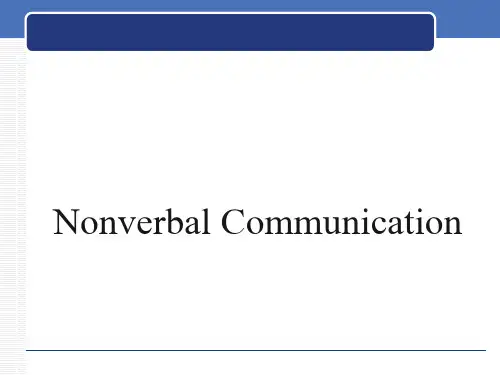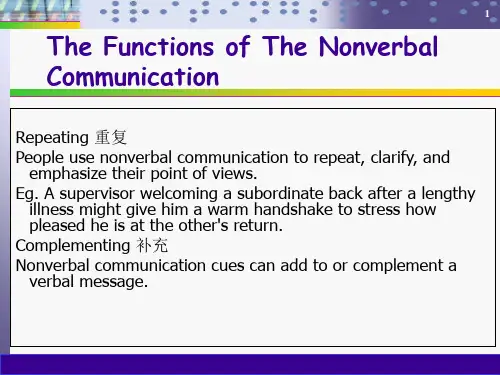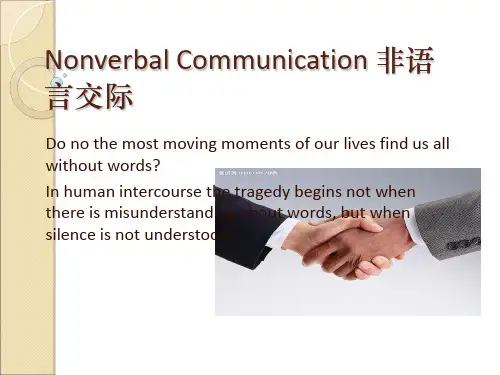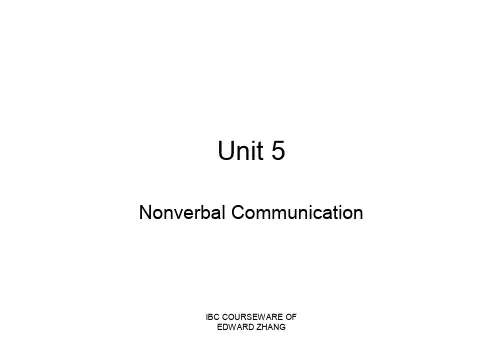nonverbalcommunication跨文化交际.ppt
- 格式:ppt
- 大小:1.58 MB
- 文档页数:83

![跨文化交际(UNIT 7)[优质ppt]](https://uimg.taocdn.com/45189eb60912a21615792900.webp)






Unit 5Nonverbal CommunicationIBC COURSEWARE OF EDWARD ZHANGObectivesI. What is nonverbal communication II. Nonverbal communication and culture III. Functions of nonverbal communication IV. The Importance of Nonverbal Communication V. Nonverbal communication: guidelines andlimitations VI. Categories of Nonverbal CommunicationIBC COURSEWARE OF EDWARD ZHANGIBC COURSEWARE OF EDWARD ZHANGI. Defining nonverbal communication• 1. Nonverbal communication involves all nonverbal stimuli in a communication setting that are generated by both the source and his or her use of the environment and that have potential message value for the source or receiver.• 2. Nonverbal messages may be both intentional and unintentional.IBC COURSEWARE OF EDWARD ZHANGII. Nonverbal communication and culture • 1. Much of our nonverbal behavior, likeculture, tends to be elusive, spontaneous, and frequently beyond our awareness.IBC COURSEWARE OF EDWARD ZHANG• 2. Culture is all-pervasive, multidimensional, and boundless; it is everywhere and in everything. The same is true of nonverbal behavior.IBC COURSEWARE OF EDWARD ZHANG• 3. Another parallel between culture and nonverbal behavior is that both need to be learned.IBC COURSEWARE OF EDWARD ZHANG• 4. Studying nonverbal behavior can lead to the discovery of a culture's underlying attitudes and values. It can also assist us in isolating our own ethnocentrism.IBC COURSEWARE OF EDWARD ZHANGIII. Functions of nonverbal communication • To repeat, complement, substitute for averbal action, regulate, and contradict a communication event.IBC COURSEWARE OF EDWARD ZHANGIV. The importance of nonverbal communication• 1.We make important judgments and decisions about others based on their non-verbal behavior.• 2. We use the actions of others to learn about their affective or emotional states.• 3. Many of our nonverbal actions are not easily controlled consciously.• 4. Nonverbal communication is important to the study of intercultural communication because a great deal of nonverbal behavior speaks a universal language.IBC COURSEWARE OF EDWARD ZHANGV. Nonverbal communication: guidelines and limitations1.It is important to remember that we are all more than our culture.2. In nonverbal communication, we often make differences more important than they should be.3. Nonverbal actions seldom occur in isolation.IBC COURSEWARE OFVI. Categories of Nonverbal Communication•1. Those primarily produced by the body: appearance, movements (kinesics), facial expressions, eye contact, touch.•2. Those the individual combines with the setting: space, time, and silence.IBC COURSEWARE OF2. Body movement (kinesics)•posture•gesturesIBC COURSEWARE OF3. Facial Expressions4. Eye contact and gaze5. TouchIBC COURSEWARE OFIBC COURSEWARE OFhe/she is ready to move at any time. his/her feelings, trying to calm down.•How Body Communicates, from head to toesIBC COURSEWARE OFHEAD-Nodding the head-“Yes”in most societies-“No”in some parts of Greece, Yugoslavia, Bulgaria, and Turkey•Tossing the head backward–“yes”in Thailand, the Philippines, India, LaosIBC COURSEWARE OFFACE IBC COURSEWARE OFIBC COURSEWARE OFEYES*Eye contacts-Encouraged in America, Canada, Europe-Rude in most Asian countries and in Africa*Winking eye-Sharing secret in America and Europe-flirtatious gesture in other countries*Closed eyes-bored or sleepy in America-“I’m listening and concentrating.”in Japan, Thailand, ChinaIBC COURSEWARE OFEars*Ear grasp-“I’m sorry.”in parts of India*Cupping the ear-“I can’t hear you.”in all societies*Pulling ear-“You are in my heart”for Navajo IndiansIBC COURSEWARE OFIBC COURSEWARE OFLIPS AND MOUTHCheeks*Cheek screw-gesture of praise -Italy-“That’s crazy.”Germany*Cheek stroke-“pretty, attractive, success”most EuropeIBC COURSEWARE OFTHE LIP POINTING*Kiss. In parts of Asia, kissing is considered an intimate sexual act and not permissible in public, even as a social greeting.IBC COURSEWARE OFTHE LIP POINTING •Finger tip kiss. In France, it conveys several messages, “That’s good!”“That’s great!”“That’s beautiful!.”IBC COURSEWARE OFIBC COURSEWARE OFTHE LIP POINTING*Open mouth. Any display of the open mouth is considered very rude in mostcountries.Fingers*The “O.K.”signal. (the thumb and forefinger form a circle) means*“fine,”or “O.K.”in most cultures,*“zero”or “worthless”in some parts ofEurope*“money”in Japan*an insult in Greece, Brazil, Italy, Turkey,Russia and some other countriesIBC COURSEWARE OFFingers*Pointing.*Pointing with the index finger iscommon in North America andEurope.*But it is considered impolite inJapan and China where theyfavor using the whole open hand.*Malaysians prefer pointing withthe thumb.IBC COURSEWARE OFIBC COURSEWARE OFHands*Of all the body parts, thehands are probably used most for communicating non-verbally.*Hand waves are used for greetings, beckoning, orfarewells.Hands*The Italian“good-bye”wave can be interpreted by Americans as the gesture of “come here.”*The American “good-bye”wave can be interpreted in many parts of Europe and Latin America as the signal for “no.”IBC COURSEWARE OFHands*Handshaking is a form of greeting in most Western cultures.*In the Middle East, a gentlegrip is appropriate.*In most Asian cultures, a gentlegrip and an avoidance of directeye contact is appropriate.IBC COURSEWARE OFHands*Right hand. The right hand has special significance in many societies. In certain countries in the Middle East and in Asia, it is best to present business cards or gifts, or to pass dishes of food, to get an attention, using only the right hand or both. *Left hand is considered unclean in much of the Middle East and in parts of Indonesia.IBC COURSEWARE OFHands*Clapping hands.*Russians and Chinese may use applause to greet someone.*In many central and eastern Europe,audience frequently clap in rhythm.IBC COURSEWARE OFNose*Holding the nose-“Something smells bad.”universal *Nose tap-“It’s confidential.”England-“Watch out!”or "Be careful.”ItalyIBC COURSEWARE OFIBC COURSEWARE OFNose*Pointing to nose-“It ’s me.”China*Blowing nose-In most Asian countries , blowing the nose at social gathering is ‘disgusting.’Arms*Some cultures, like the Italians, use thearms freely. Others, like the Japanese,are more reserved; it is considered impolite to gesticulate with broadmovements of the arms.*Folding arms are interpreted by somesocial observers as a form of excluding self, “I am taking a defensive posture,”or“I disagree with what I am hearing.”IBC COURSEWARE OF*Arms akimbo. In many cultures, thisstance signals aggression, resistance, impatience, or even anger.*Arms behind back, hands grasped is a sign of ease and control.*Arms in front, hands grasped, common practice in most Asian countries, is a sign of mutual respect for others.IBC COURSEWARE OFIBC COURSEWARE OFLegs & Feet*In Asia, do not point with your toes.*In Asia and some European countries, putting feet up on a desk or any other piece of furniture is very disrespectful.*Sitting cross-legged, while common in North America and some European countries, is very impolite in other parts of the world.IBC COURSEWARE OFCase Study•Study the following three cases and explain what messages smiles and laughter usually convey.IBC COURSEWARE OFCase Study1. In a Chinese classroom a girl was asked to answer a question. She stood up and smiled, without making any sound.2. When an American is parking his bicycle and the bicycle accidentally fall over, he feels embarrassed at his awkwardness, and is quite angered and humiliated when Chinese onlookers laugh.3. In the dining room, when an American drops a plate quite by accident and feels bad, and Chinese onlookers laugh, compounding his discomfort and causing anger and bad feelingIBC COURSEWARE OFSmile and laughter•Smile and laughter usually convey friendliness, approval, satisfaction, pleasure, joy and merriment.•In case A, the girl smiled to cover her embarrassment resulting from not being able to answer the question.•In case B and C, the laughter is not at the person or his misfortune –whether he is aIBC COURSEWARE OFSmile and laughter foreigner or a Chinese. It can convey a number of feelings: don’t take it so seriously; laugh it off, it’s nothing’such things can happen to any of us.IBC COURSEWARE OFSpace and Distance •Space includes the personal space and territoriality.•Animals and human beings both stake out to defend their territories.•The territorial invasion of a country may lead to the declaration of war. But people as individuals may not be so pugnacious (好斗的).• A more tangible form of communication between people is the use and control of space.IBC COURSEWARE OFNorth Americans’distance habit0~45cm:intimate lovers and family members45~80cm:friends (personal distance)130~300cm:acquaintances (social distance)>270cm:public space, not belong to oneself Behind:strangers speaking from behind are allowed to stand much more nearer.IBC COURSEWARE OFSpace and Distance•Personal spaceEdward T. Hall suggests that “each person has around him an invisible bubble of space which expands and contracts depending on his relationship to those around him, his emotional state, and the activity he is performing.”Based on his observations of North Americans, Hall developed four categories of distance in human interactions:IBC COURSEWARE OF•(1) Intimate distance: ranging from body contact to 18 inches, this distance is used for personal contact, comforting, and protecting.** 一英寸=2.54厘米IBC COURSEWARE OF•(2) Personal distance: from 18 inches to 4 feet, depending on the closeness of the relationship, in this distancing mode people have an visible “space bubble”separating themselves from others.** 1英尺(ft)=0.3048米(m)IBC COURSEWARE OF•(3) Social distance: from 4 to 12 feet, this distance is used by acquaintances and strangers in business meetings and classrooms.IBC COURSEWARE OF。


